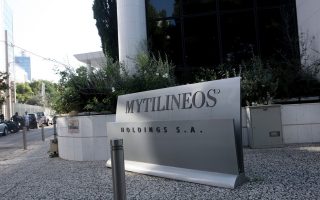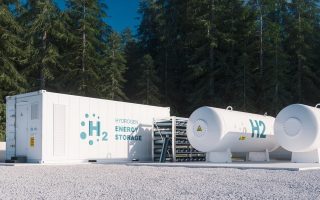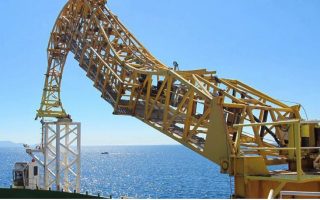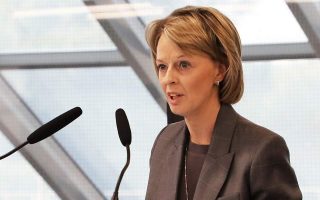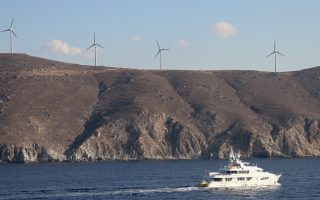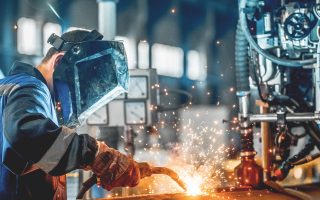DESFA CEO talks about her new position, natural gas, the future of the sector
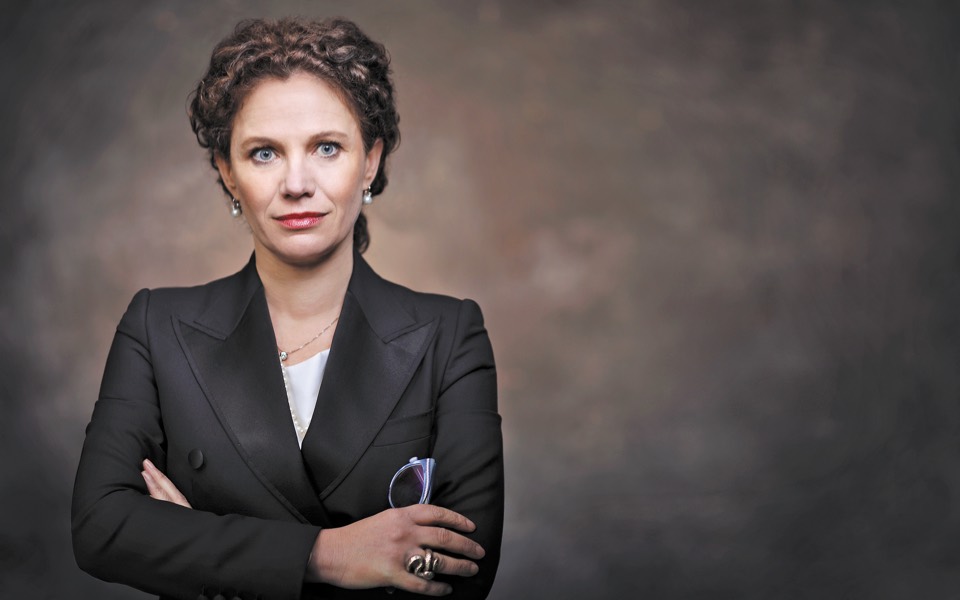
Maria Rita Galli has been at the helm of the Hellenic Gas Transmission System Operator (DESFA) since February. She has been part of the energy sector since 1997 and until recently had been an executive at Italian company Snam. She played a leading role in the privatization of DESFA as the president of the Senfluga joint venture that now controls the company.
“The challenge of being a CEO of a company is the same for men and women,” Galli states in her first interview with Kathimerini after taking up the position. The energy transition is a challenge, but also at the same time, a big opportunity for a company like DESFA, she stresses. She mentions the importance of natural gas in this energy transition, but also talks about the future of natural gas infrastructure, which she stresses is interlinked with the transmission of other clean fuels, such as hydrogen, biomethane and synthetic fuels.
To fund expansion projects to grow the system in Western Macedonia and Patra, projects recently excluded from the recovery fund, DESFA has turned to alternate sources of funding, whether that be European Union funds or private financing through banks. The new FSRU Alexandroupoli and Dioryga Gas natural gas infrastructure is not in competition with Revithoussa, while the underground storage project in Kavala, bid for by DESFA in cooperation with GEK Terna, will, according to Galli, reinforce not only Greece’s energy security but that of the whole region.
The CEO of DESFA also spoke about the importance of Greece as a crossroads for natural gas, exports to Bulgaria in 2020, the record demand in the domestic market, and the record of profitability, which will allow for a reduction of rates for consumers in the future.
We don’t see many women in company leadership roles. What is it like?
I have been in the energy sector since 1997 and throughout the years I have seen conditions and circumstances change. Certainly, in 97, being a woman in the oil and gas industry was a big challenge. Today, more and more women are involved in the energy sector and are beginning to gain more expertise and experience, as well as more responsibilities and leadership roles. It is very important that more young women are entering STEM fields of study, which are the basic qualifications to work in the sector.
The challenge of being a CEO is the same for both men and women. Of course, the responsibility is different and I feel the responsibility of this role; however, I can definitely rely on an excellent management team, and this helps me understand the challenges of running such a company.
I must say that I was not treated any differently as a woman by my colleagues at DESFA. I have been following DESFA’s privatization since 2017 and I was on the board of Senfluga, which is the main shareholder of DESFA since 2018, when the process was completed, but it is clearly very different to follow a company as a member of the board, rather than being inside it.
Assuming the position of the CEO of DESFA, I realized that there is a very important transformation program in place, as well as many opportunities for the company and its employees.
The biggest challenge today is the energy transition. How does DESFA view it?
The energy transition is definitely a challenge in itself, but for a company like DESFA it is also a great opportunity. Natural gas is a fuel that will play an important role in the energy transition and is certainly necessary for RES [renewable energy sources] to be integrated into the energy mix and to be able to balance the intermittence resulting from solar and wind energy.
Natural gas has, in principle, a very clear advantage in the sense that it can be stored. It can ensure adequate energy even when it is not sunny or when it is not windy. In addition, it is certainly the only solution available for the decarbonization of industries that are difficult to electrify. We have some heavy industries, such as those of iron, cement etc, that need very high heat that cannot be produced from other energy sources, with natural gas providing a solution. Gas pipelines can help with the transition as gas is readily available, abundant, affordable and more sustainable than other fossil fuels and in the future the pipelines could be used to transport other clean fuels, such as hydrogen, biomethane or synthetic gases.
This is a view expressed by DESFA and other energy companies, but the EU does not seem to recognize it and has outsourced gas projects.
This may have to do with the fact that gas networks in the rest of Europe are already quite mature. The region of Southern Europe is different and more investments are needed, regarding infrastructure, in order to replace coal and switch to other fuels.
Does that mean the EU can approve exceptional project funding?
The role of existing gas pipelines is widely recognized in the EU as strategic for the transition to green gases.
Some criteria should say that projects which can be adapted to carry renewable gases are not rejected. These have a profile named “do-no-harm projects,” meaning that they do not burden. The debate is open so what we are trying to do is to highlight and convince that energy companies and associations need gas infrastructure in order to move on to the next day. They have a positive impact and do no harm; on the contrary, they favor the transition.
So the future of this infrastructure goes through the possibility of transport and renewable fuels.
Yes. All gas companies are currently working to ensure that the gas infrastructure is ready to transport biomethane or hydrogen, at first in a mixture with natural gas, and pure hydrogen in the future.
DESFA has an ambitious investment plan of around half a billion euros. What are the company’s priorities?
There are three categories of projects in DESFA’s 10-Year Development Plan. The first category has to do with the Revithoussa LNG [Liquefied Natural Gas] Terminal and essentially the investments that will open the market for small-scale LNG. These projects will allow the use of LNG and its transport to consumers off the grid and will be used as fuel for heavy trucks. It will also be possible for LNG to be trans-shipped on small ships for use as marine fuel and, in the future, of course, to be able to power the islands and replace diesel. The second category of projects concerns new metering stations in Ambelia [in Thessaly] and Kipoi [near the Greek-Turkish border], which are necessary for strengthening the gas network and facilitating the interconnection with TAP [Trans Adriatic Pipeline] and in the future the interconnection with the FSRU [Floating Storage Regasification Unit] at Alexandroupoli and the IGB [Gas Interconnector Greece-Bulgaria], in order to ensure the injection of gas coming from different sources into the system. The third category of projects has to do with development projects. We have essentially two national projects, the pipeline in Western Macedonia and the pipeline in the area of Patra that will enable new areas to be supplied with natural gas and essentially replace the use of coal as a fuel. These projects contribute to the goals for de-lignification. The third of them is an international project concerning the interconnection of the country with North Macedonia.
How will the projects for the system expansion in Western Macedonia and Patra proceed after their non-inclusion in the recovery fund?
We are exploring and trying to find alternative ways of financing, either through the current NSRF [National Strategic Reference Framework / ESPA] or through bank loans, to ensure that the specific projects will receive the funding they need to be implemented. Clearly, the most important benefit of funding projects like these through the recovery fund or NSRF is that their cost will be lower for end users.
We have the new FSRU Alexandroupoli and Dioryga Gas infrastructure. What phase is DESFA’s entry into the FSRU Alexandroupoli at? Are these two new station terminals complementary to Revithoussa or in competition with it?
Regarding our participation in FSRU Alexandroupoli, we have already signed the contract for 20% of the share capital of Gastrade, the company that is developing the project, and the relevant contract has been submitted for approval by the EU as requested by legislation. The request has passed the first phase of pre-approval and is expected to be formally submitted in the coming weeks. Last year and the year before, gas demand rates were very high. Revithoussa operated at 100% capacity last year and clearly this demand not only concerns Greece, but also covers the needs of the wider Balkan region. So, one should see any new project in relation to the needs of the wider area. FSRU Alexandroupoli will mainly supply Bulgaria and the other Balkan countries through IGB. As for other infrastructure facilities, such as the Dioryga Gas FSRU, the market itself will judge their competitiveness. Dioryga Gas should carry out a market test anyway and, clearly, whether the market is interested in booking capacities is important. Most terminals ensure diversification of supply sources, increase market liquidity and certainly have a much greater impact on prices. That is why we always support projects that strengthen the gas system.
You are also one of the two contenders for the project of converting the South Kavala natural gas field into an underground natural gas storage facility (UGS). How does this project fit in with the other terminals?
Energy storage is a critical element for strengthening the regional energy role and the energy security of the country, as well as of the wider region, in order to be able to accommodate the energy demand of industrial and residential users and balance the system. Strengthening the national gas network with the addition of a storage facility paves the way for the future integration of renewable gases.
With the current data of the natural gas infrastructure in the wider region, can Greece really become a natural gas hub?
With the operation of ΤΑΡ, but also before ΤΑΡ, in 2019, we exported gas for the first time through the Border Metering Station of Sidirokastro in northern Greece, so one would say that this trend is much more relevant than ever. Greece is in a very good position, which is strengthened for gas exports and helps the wider region with natural gas flows from various sources.
The DESFA shareholders are participating in an energy transition project. How will DESFA utilize its shareholders’ know-how?
Clearly, our shareholders can help us in several areas, with one of them being the new projects and how to ensure that these are ready to carry hydrogen in our network. They also help us to be able to assess the condition of existing facilities and infrastructure and to strengthen them, so that we can transport the gas mixture with hydrogen. We can certainly use their expertise in other areas too, such as biomethane production, which Greece does not have at the moment, but also to be able to contribute to the part of the circular economy. We work with our shareholders on various big initiatives, such as “Gas for Climate,” involving Snam, Enagas, Fluxys, DESFA and other companies, and, essentially, create good practices on how to move to a zero-emission economy. We hope that soon we will be able to analyze all the factors, in order to create these opportunities for Greece.
You announced record gas consumption in 2020 and the administrator’s forecasts for 2021 are similar. The president of the company recently spoke of record profits in 2020. Does DESFA aim to return part of these profits to consumers by reducing user charges?
2020 was a very good year not only for domestic consumption, but also because many LNG consignments were exported to Bulgaria. This was also exceptional for another reason. LNG prices were very low due to the effects of the pandemic on Asian markets and this led to a lot of LNG being imported through Revithoussa into other Balkan markets. Our revenues are regulated by RAE. This means that if 2020 was an exceptional year, when revenues have been higher than the regulated revenues, these will be given back through lower revenues in the future. There is a specific mechanism which ensures that if there are higher revenues than expected, the excess will be returned to the final consumer and in the event that revenues are lower than expected, then there is a respective coverage allocation.
Have you calculated the reduction in tariffs?
Tariffs for 2021 are lower than those of 2020 and have been steadily declining since 2015.
